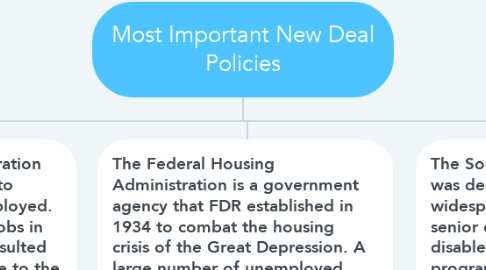Most Important New Deal Policies
by Wilfredo Couret

1. The Civilian Conservation Corps was created in 1933 by FDR to combat unemployment. This work relief program had the desired effect, providing jobs for many thousands of Americans during the Great Depression. The CCC was responsible for building many public works projects and created structures and trails in parks across the nation that are still in use today.The Civilian Conservation Corps was created in 1933 by FDR to combat unemployment. This work relief program had the desired effect, providing jobs for many thousands of Americans during the Great Depression. The CCC was responsible for building many public works projects and created structures and trails in parks across the nation that are still in use today.
2. The Civil Works Administration was also created in 1933 to create jobs for the unemployed. Its focus on high-paying jobs in the construction sector resulted in a much greater expense to the federal government than originally anticipated. The CWA ended in 1934 in large part because of opposition to its cost.
3. The Federal Housing Administration is a government agency that FDR established in 1934 to combat the housing crisis of the Great Depression. A large number of unemployed workers combined with the banking crisis resulted in a situation in which banks recalled loans and people lost their houses. The FHA was designed to regulate mortgages and housing conditions; today it still plays a major role in the financing of houses for Americans.
4. The Social Security Act of 1935 was designed to combat widespread poverty among senior citizens and to aid the disabled. The government program, one of the few parts of the New Deal still in existence, provides income to retired wage earners and the disabled who have paid into the program throughout their working lives via a payroll deduction. The program has become one of the most popular government programs ever and is funded by current wage earners and their employers. The Social Security Act evolved from the Townsend Plan, an effort to establish government-funded pensions for the elderly led by Dr. Francis Townsend.
5. The Works Progress Administration was created in 1935. As the largest New Deal agency, the WPA affected millions of Americans and provided jobs across the nation. Because of it, numerous roads, buildings, and other projects were built. It was renamed the Works Projects Administration in 1939, and it officially ended in 1943.


